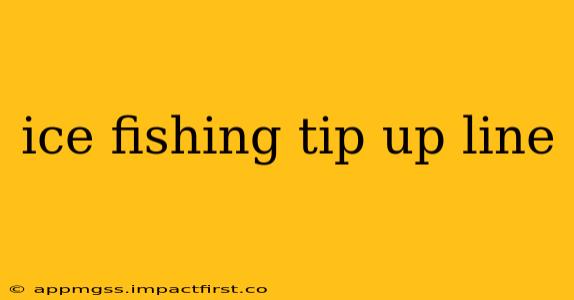Ice fishing tip-ups are a thrilling way to experience the winter wonderland while targeting a variety of fish species. However, selecting and managing the right line is crucial for a successful outing. This comprehensive guide covers everything you need to know about ice fishing tip-up lines, ensuring you're well-equipped for your next winter fishing adventure.
What Kind of Line is Best for Ice Fishing Tip-Ups?
The ideal line for ice fishing tip-ups balances strength, visibility, and sensitivity. Several options exist, each with its own pros and cons:
-
Monofilament: This classic choice offers good strength-to-diameter ratio, making it a popular choice among ice anglers. It's relatively inexpensive and readily available. However, monofilament can stretch under load, potentially affecting the sensitivity of your tip-up. Choose a line with a breaking strength appropriate for the species you're targeting.
-
Fluorocarbon: Known for its low visibility underwater, fluorocarbon is an excellent option for wary fish. It's also more abrasion-resistant than monofilament. The downside is its higher cost and stiffness, which can affect casting and tangle more easily.
-
Braided Line: This super strong line has a thinner diameter than mono or fluoro for the same breaking strength, allowing you to use a smaller diameter spool on your tip up. Braided line's low stretch provides excellent sensitivity and helps prevent line slack. However, it can be more visible in the water than monofilament or fluorocarbon and is more prone to cutting when rubbing against sharp edges.
What Line Strength Should I Use for My Ice Fishing Tip-Up?
Choosing the right line strength depends heavily on the target species. Larger, stronger fish require heavier line, while smaller fish can be effectively caught with lighter lines. Consider these guidelines:
- Panfish (Bluegill, Sunfish, Perch): 2-4 lb test line is generally sufficient.
- Walleye, Northern Pike: 6-10 lb test line is recommended.
- Large Lake Trout, Muskie: 12-20 lb test line or even heavier might be necessary.
Remember to always account for the potential of snags and the extra strain placed on your line during the fight.
How Much Line Should I Use on My Ice Fishing Tip-Up?
The amount of line needed on your tip-up spool varies depending on the depth you're fishing and the size of your spool. As a general rule, leave enough line to reach the bottom plus an additional 2-3 feet for the fish to run. Overfilling your spool can cause tangles and make it difficult to manage your line.
How Do I Prevent My Ice Fishing Tip-Up Line from Freezing?
Freezing line can be a major issue during ice fishing. To minimize this, consider these tips:
-
Use a line conditioner: Many products are designed to prevent line freeze-up. Apply according to product directions.
-
Keep your tip-up in a sheltered area: Try to avoid setting your tip-ups in areas with direct wind exposure.
-
Avoid excessively wet line: If your line is wet, let it dry before spooling it.
-
Use a protective cover: Some anglers use zip ties, rubber bands or fabric to keep the spool and the line slightly covered.
What Size Spool Should I Use for My Ice Fishing Tip-Up?
Spool size is directly related to line capacity and the amount of line you'll be using. Larger spools hold more line, beneficial for deeper water or longer casts. Smaller spools are sufficient for shallow water ice fishing situations. Consider your typical fishing depth when choosing your spool size.
How Do I Properly Set Up My Tip Up Line?
Properly setting up your tip-up line is essential to prevent tangles and ensure smooth operation. Ensure the line is properly seated on the spool to avoid sudden spooling issues when a fish hits your bait. Avoid any kinks or twists while preparing your line. You should also always have a leader with the appropriate weight.
By understanding these aspects of ice fishing tip-up lines, you’ll significantly improve your chances of a successful and enjoyable ice fishing experience. Remember to always prioritize safety and respect the environment. Tight lines!
